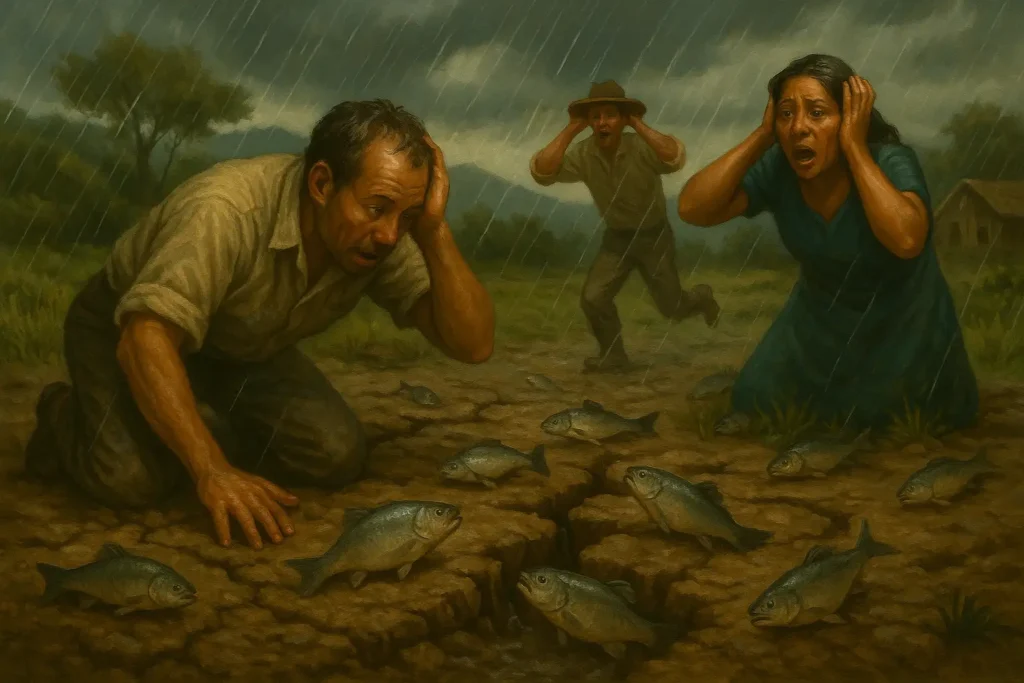When the Sky Doesn’t Rain Water—But Fish
Few natural events are as startling as animal rain—episodes where living creatures like fish or frogs literally fall from the sky. In Yoro, a small town in the interior of Honduras, this happens almost every year. After heavy storms, residents walk the streets collecting live fish scattered on the ground, as if they had just dropped from the clouds.
The Honduran case, known as Lluvia de Peces, has become a tourist attraction. However, it is not unique. Reports of animals falling from the sky have surfaced in several countries—often unexpectedly and, in many instances, without a definitive explanation. Science offers hypotheses, while folklore proposes magical interpretations. Ultimately, what remains is the wonder: something seemingly impossible unfolds before our eyes and challenges the boundaries of what we call “natural.”
You may also like:
What Is Animal Rain?

Illustrative image of a waterspout lifting animals into the air.
Despite its almost mythical name, animal rain is a well-documented phenomenon in various parts of the world. It is most commonly associated with severe storms, waterspouts, or extremely strong vertical winds. These weather events can lift light animals—such as fish, frogs, and even small crustaceans—high into the air and carry them over long distances.
What’s most astonishing is that these occurrences often involve more than just a few animals. There are accounts of hundreds or even thousands of creatures scattered across entire areas. Furthermore, some animals land still alive. On the other hand, some are found frozen, injured, or already dead.
These events challenge our understanding of the natural world. After all, the sky is supposed to give us rain, hail, or snow—not living beings.
Famous Cases Around the World

Photo of fish rain in Honduras.
Yoro, Honduras – The Most Famous of All
The most frequently documented case of fish rain happens in Yoro, a small Honduran city where the event typically occurs between May and July, following intense storms. Locals even hold a festival—the Festival de la Lluvia de Peces—featuring parades and religious ceremonies. The fish found on the ground are usually small, silver-colored, and, according to residents, come “from the sky.” Some researchers suggest these fish may live in underground caves and are pushed to the surface by flooding. However, many reports say the fish appear even when no rivers are nearby.
Marksville, USA – A Clear-Sky Rain
In 1947, the town of Marksville, Louisiana, witnessed a rain of fish that occurred without any storm at the time. Eyewitnesses said the fish were intact and alive. Newspapers covered the story, and meteorologists investigated—but no conclusive explanation was ever found.
Sremska Mitrovica, Serbia – Frogs From the Clouds
In 2005, residents of Sremska Mitrovica watched the sky darken as a dense cloud approached. But instead of rain, hundreds of frogs fell to the ground. The story made headlines across Europe. Scientists attributed the event to a possible waterspout that had formed over a nearby lake, sucking up the animals and carrying them into town.
What Can Science Explain?

Waterspouts and Tornadoes
The most common explanation for animal rain involves waterspouts—rotating air columns that form over lakes or oceans, capable of lifting water and small animals into the atmosphere. Once airborne, the animals may travel for kilometers before falling due to gravity or being released during rainfall. Land-based tornadoes can have a similar effect, especially in swampy regions.
Underground Water Currents
In Yoro’s case, some researchers propose that the fish don’t fall from the sky at all. Instead, they believe underground water networks may force fish to the surface during heavy rainfall. The issue with this theory is that locals insist the fish appear even in dry regions, far from any natural springs.
Limits of the Theories
While these hypotheses are plausible, none of them fully explain all reported cases. There are records of animal rain occurring in places with no nearby water sources, no preceding storms, and no wind patterns capable of transporting living creatures. Therefore, the mystery persists—and scientists continue searching for more comprehensive answers.
When Nature Defies Logic
Animal rain is one of those phenomena that sound fictional but are real. Its existence is confirmed in newspapers, meteorological records, and numerous eyewitness accounts. Precisely because it’s not yet fully understood, it continues to fascinate—and puzzle—scientists, skeptics, and everyday observers alike.
On a planet that features upside-down lightning, rocks that move on their own, and deserts where radio signals mysteriously fail, perhaps the idea of animals falling from the sky isn’t so far-fetched after all.
References
Marksville, Louisiana (1947) — Fish ranging from 5 to 23 cm fell from a clear sky after an unusual storm in the region.
Source: Time MagazineKansas City, USA (1873) — Reports of frogs falling from the sky during heavy rain, documented in newspapers from the time.
Source: Connecticut Science CenterSremska Mitrovica, Serbia (2005) — Hundreds of frogs reportedly fell after a local storm, confirmed by eyewitnesses and media coverage.
Source: Connecticut Science CenterWaterspouts as scientific explanation — Waterspouts forming over bodies of water can suck up fish and amphibians, carry them through the air, and release them far from their original location.
Source: Live ScienceUnderground current theory in Yoro — Some believe the fish come from underground caves or waterways and are flushed to the surface during intense rainfall.
Source: Wikipedia – Lluvia de Peces
Posts Recomendados
Carregando recomendações...



